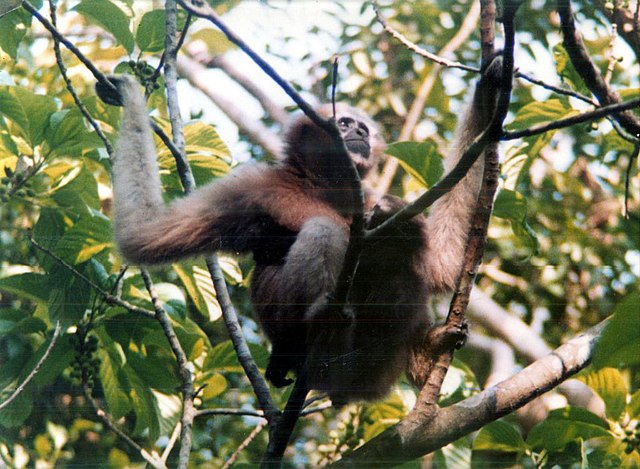Gibbons are apes in the family Hylobatidae. The family historically contained one genus, but now is split into four extant genera and 20 species. Gibbons live in subtropical and tropical rainforests from eastern Bangladesh to Northeast India to southern China and Indonesia.
Northern white-cheeked gibbon, Nomascus leucogenys
Agile gibbon, Hylobates agilis
Pileated gibbon (Hylobates pileatus)
Genus Hoolock
Apes are a clade of Old World simians native to sub-Saharan Africa and Southeast Asia, which together with its sister group Cercopithecidae form the catarrhine clade, cladistically making them monkeys. Apes do not have tails due to a mutation of the TBXT gene. In traditional and non-scientific use, the term ape can include tailless primates taxonomically considered Cercopithecidae, and is thus not equivalent to the scientific taxon Hominoidea. There are two extant branches of the superfamily Hominoidea: the gibbons, or lesser apes; and the hominids, or great apes.The family Hylobatidae, the lesser apes, include four genera and a total of 20 species of gibbon, including the lar gibbon and the siamang, all native to Asia. They are highly arboreal and bipedal on the ground. They have lighter bodies and smaller social groups than great apes.
The family Hominidae (hominids), the great apes, include four genera comprising three extant species of orangutans and their subspecies, two extant species of gorillas and their subspecies, two extant species of panins and their subspecies, and humans in a single extant subspecies.

Ape
Like those of the orangutan, the shoulder joints of hominoids are adapted to brachiation, or movement by swinging in tree branches.
This series of images shows a gorilla using a small tree trunk as a tool. The trunk is used to maintain balance while fishing for aquatic plants







